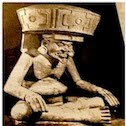Christopher Columbus sailed to Chios when he was about 23 or 24 (1) Married Felipa Moñiz Perestrello of Lisbon, daughter of navigator who found Port Santo (Madeira) and left many charts and nautical instruments. He went with his brother Bartholomeo in 1488 to John II of Portugual and Henry VII of England with his ideas of India through the Atlantic Ocean but was not successful. (1)
Christopher Columbus had sailed before to Guinea in Africa and to the Northlands. Eventually, as a good God-fearing Christian, he took his son to the monastery at Rabida, (2) and convinced a monk that he knew where the Indies was located. It is more likely that he had been a prisoner, and his son was held hostage, but there is only the beautiful tale that Columbus went to the monastery for food and assistance.
Eventually, the monk, and Columbus convinced the King and Queen of Spain that the goal of the Indies as a possibility. The people involved in this great adventure across unknown seas were once placed on a modern map of the Galapagos. The islands bore the names of the king, queen, the monk, and the person who supplied the funds for the journey. The map was changed somewhere in the 1970's or a few years earlier. My Geography class donated the old geography book, (Goode, J.P. (1957) World Atlas Physical, Political, and Economic [Tenth ed.] Chicago, Illinois: Rand McNally & Company) because the new names replaced those tell-tale island names.
During the time Columbus was roaming around Europe looking for a patron, many heretics were to take a pilgramage to Santiago de Compostela. One of the stops many made before going to the Cathedral of Santiago, was a small church at Mugia, Spain. It was the Church of Nuestra Señora del Barco, Our Lady of the Boat. It is pretty obvious that many pilgrims died on the journey for lack of f money for food and housing, but those who succeeded in making the arduous journey received a special blessing from Our Lady. Her feast day was and still is October 12.
Now, where did I see that date? Oh, yes, it is today. The day that Christopher Columbus discovered the Americas. What better way to warn the pilgrims who could afford passage on ships to flee the Inquisition by crossing the ocean to a safe haven, except the date of a very obscure church on the northwestern coast of Spain. In that way, all pilgrims would have heard the news about the Americas and be forewarned that the Inquisition was going to be there soon also.
In old maps of Texas and Mexico, there are colonies called Nueva Viscaya, and people in the western states of North America, that claim to have Hebrew ancestors. These maps are Texan maps, but extend into Mexico proper. Interesting, more so because of some insignificant details, the names have been brushed aside by history. Hurray for October 12 and Our Lady of the Boat.
________________________
Encyclopedia Americana, (1946 edition, Volume VII, p. 339) and Bibliography (Note 1:) Henry Vignaud <Histoire critique de la grande enterprise de Christophe Colomb> (Paris, 1911); <Toscanelli and Columbus> (London, 1903) <Etudes critiques sur la vie de Colomb avant ses découvertes> (Paris, 1905)
(2) La Gran Encyclopédie. Tours: E. Arrault et Cie. p. 7, Rabide Monastère de espagnol en Punta Umbria, province Huelva was XIII century. It was primarily a Christian Fortress, of a military order of the Templars, that the Arabs named Rabidas. Then it became a Franciscan monastery. très repandues in Spain Was Roman and Visigoth of Cordova style.
(2) La Gran Encyclopédie. Tours: E. Arrault et Cie. p. 7, Rabide Monastère de espagnol en Punta Umbria, province Huelva was XIII century. It was primarily a Christian Fortress, of a military order of the Templars, that the Arabs named Rabidas. Then it became a Franciscan monastery. très repandues in Spain Was Roman and Visigoth of Cordova style.

